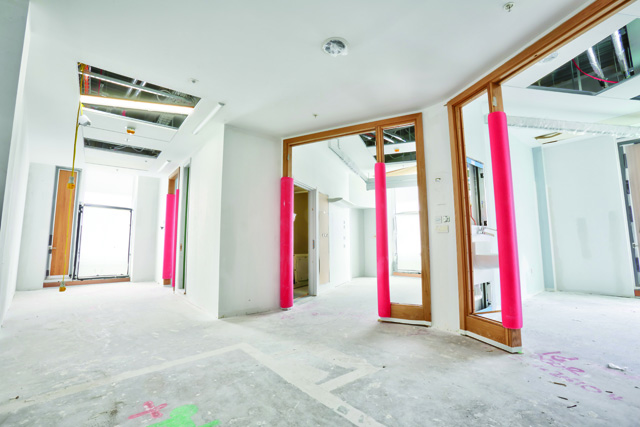In 2008, construction output from the combined public and commercial health sectors reached a peak of £5.4 billion, but as the financial crisis began to unfold, its impacts alongside austerity measures weighed significantly on performance. Amandeep Bahra from the Construction Products Association looks at an upturn in the sector.
This year is likely to mark an upturn for the health sector, supported by an increase in publicly financed projects as spending cuts fall on day-to-day spending, rather than capital investment. In addition, growth in new orders for privately funded work will also contribute to the sector’s recovery. As a result, we forecast health output to grow at a modest rate of 0.4 per cent in 2015, with a faster pace of growth forecast over the subsequent four years.
New orders point towards growth
Health sector construction output totalled £2.4 billion in 2014, declining 16.1 per cent from a year earlier. This marked the fourth consecutive year of contraction for the sector, with output standing well below its 2008 peak by 54.7 per cent. While it does appear a long way off before output returns to its peak levels, growth in new orders has been robust over the turn of this year, which will kick-start the sector’s recovery. Since the final quarter of 2014, new orders have increased for two quarters with both publicly financed and privately financed health orders contributing to this increase. These new orders will filter through into activity over the next 12 months and beyond.
Primary care will be at the heart of NHS spending
Although health construction accounts for only a small proportion of total output in the construction industry (2.0 per cent in 2014), a pipeline of new build and refurbishment work on large and small projects will drive demand for fit-out and interiors work. Public spending on health is expected to increase in real terms every year in this parliament, underpinning the return of the sector’s fortunes. According to the Summer Budget 2015, the capital spending allocation for the NHS rose to £4.6 billion in 2015/16 from £4.0 billion in 2014/15.
Looking ahead, investment in the primary care estate is expected to be at the heart of the NHS’s priorities, as reported in its Five Year Forward View report published in October 2014. This was echoed in the £1 billion Primary Care Infrastructure Fund, announced by the government in December 2014, a four-year investment programme aimed at increasing the capacity of GP practices by either improving current premises or developing new ones, as well as upgrading technology. As of March, 1,000 GP practices have had bids approved for funding.
Indeed, investment in primary care has often fallen significantly behind that of hospitals, but over the forecast period, investments in NHS facilities will focus on refurbishment programmes and improving existing facilities. These projects are likely to be at the smaller end of the scale, procured through the six-year ProCure21+ programme, but are not short on volume. In August, there were 288 active projects in the programme, including 243 valued over £1.0 million.
Beyond ProCure 21+, a number of large projects have also received public funding, which will contribute to activity in the sector. These include a £250 million funding for two Proton Beam Therapy centres – one in London and the other in Manchester – both currently in their pre-construction phase but expected to reach completion in 2018. Also, construction on a £480 million redevelopment of the Royal Sussex County Hospital, which will include new buildings and facilities, is currently underway. On the public side, health construction is forecast to have increased 6.1 per cent by 2017, to a value of £1.7 billion.
A slow take-off for PF2
Privately financed construction accounted for 36.5 per cent of total output in the health sector in 2014, the lowest since 1998 after the government halted the use of private finance initiatives (PFI) following post-recession budgetary concerns over value for money. Renewed interest in taking capital investment off the public books came with the launch of PF2, the successor to PFI, in December 2012.
Since then, we have had announcements of projects to be funded under the model, but no work has started on the ground. Although major projects have already received approvals, delays in procurement have held back work from kicking-off. The £353 million 670-bed Midland Metropolitan Hospital in Smethwick – the first hospital to be built under the revised private finance scheme – is expected to see construction begin in 2016, subject to funds being secured by the end of this year.
Similarly, it has not been plain sailing for the North Tees and Hartlepool Wynyard Hospital, which has seen procurement for main works being held up following uncertainty over securing government approval. Once progress accelerates under the government’s PF2 programme, growth in the health sector will also receive a boost from activity in private healthcare projects.
Despite several large privately funded projects in the pipeline, publicly financed projects are still likely to be the key driver of growth over the medium-term, supported by large-scale hospital redevelopments and smaller-scale projects under Procure 21+. Overall, the Construction Products Association forecasts total health construction output to grow by 3.0 per cent each year between 2016 and 2019.


